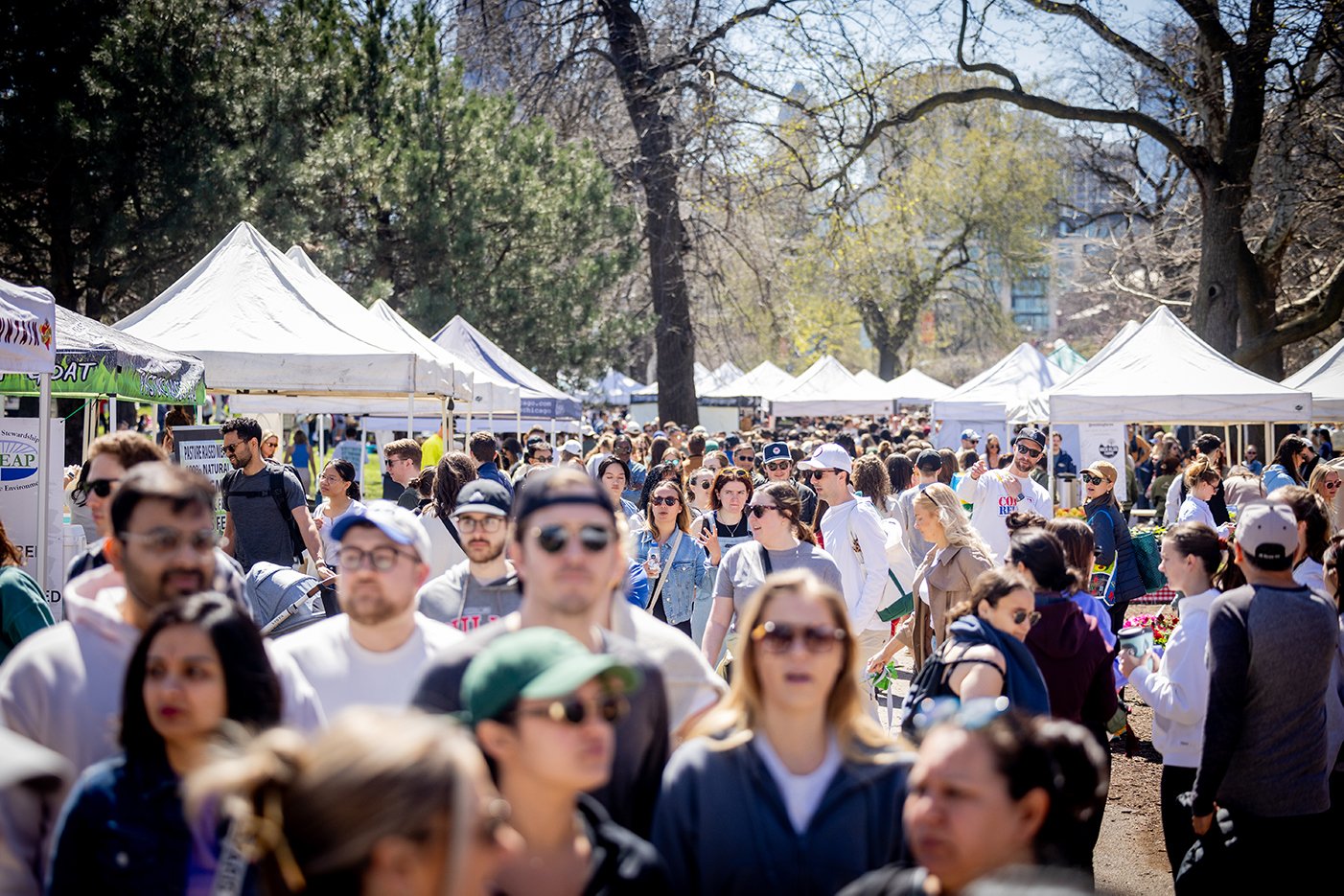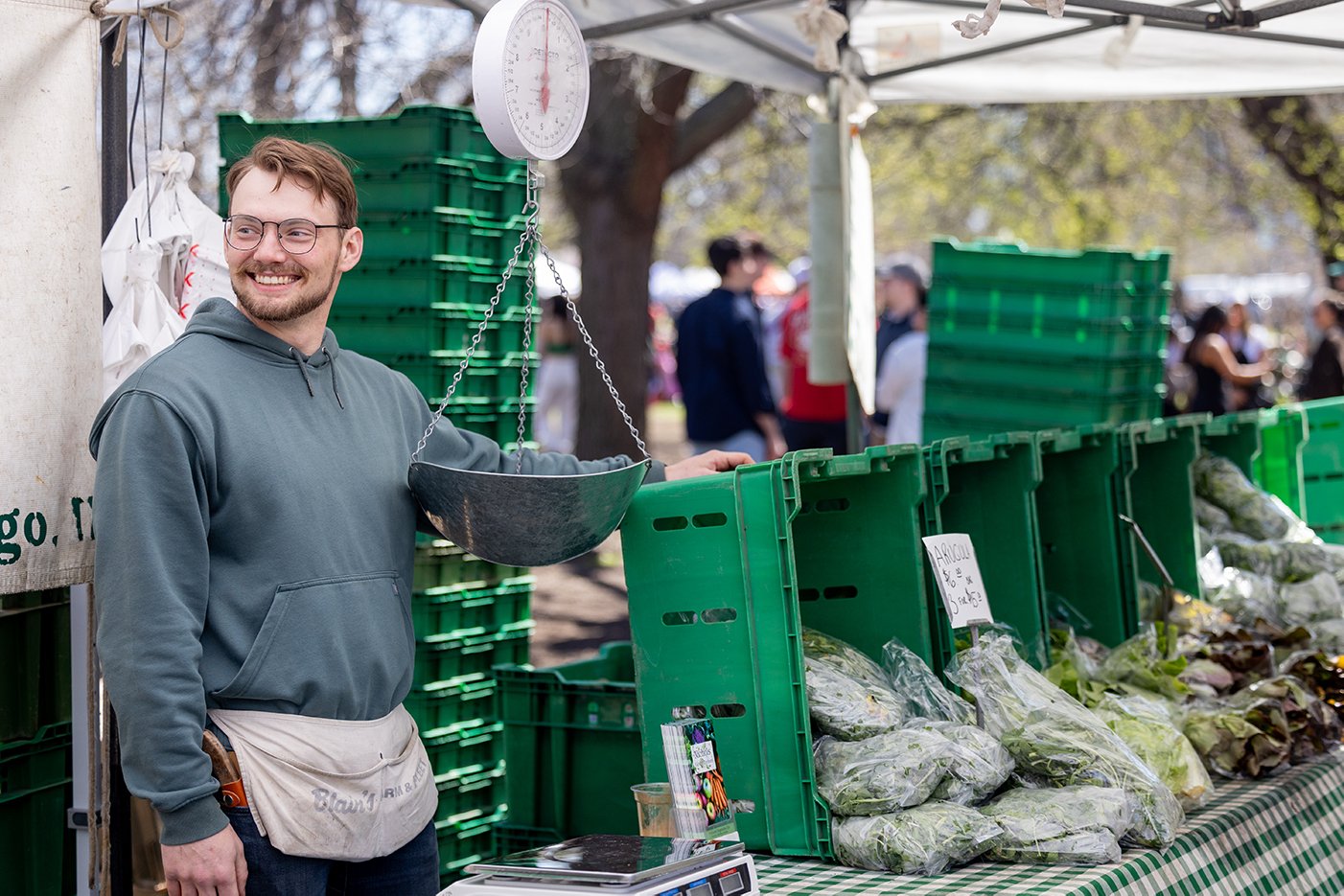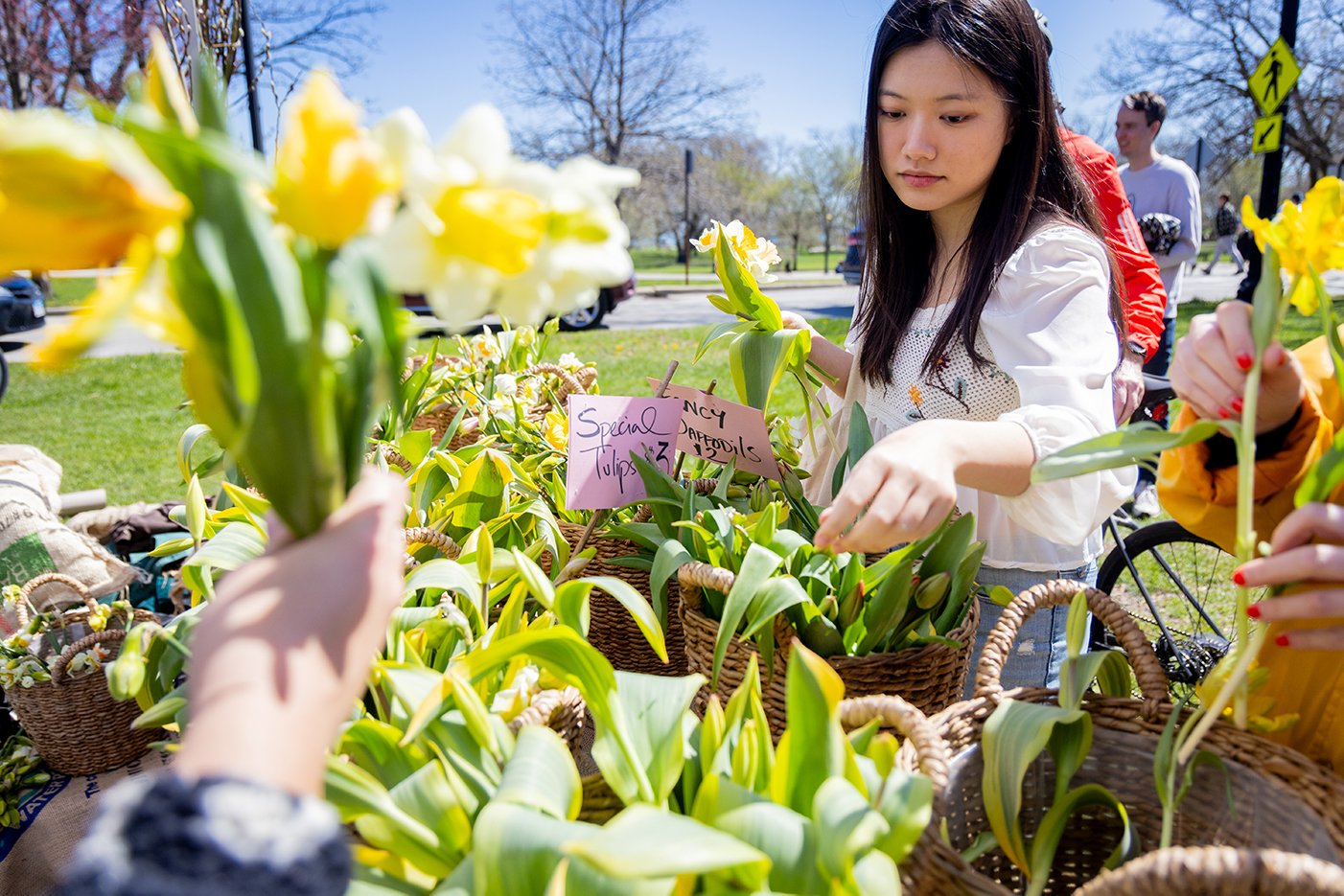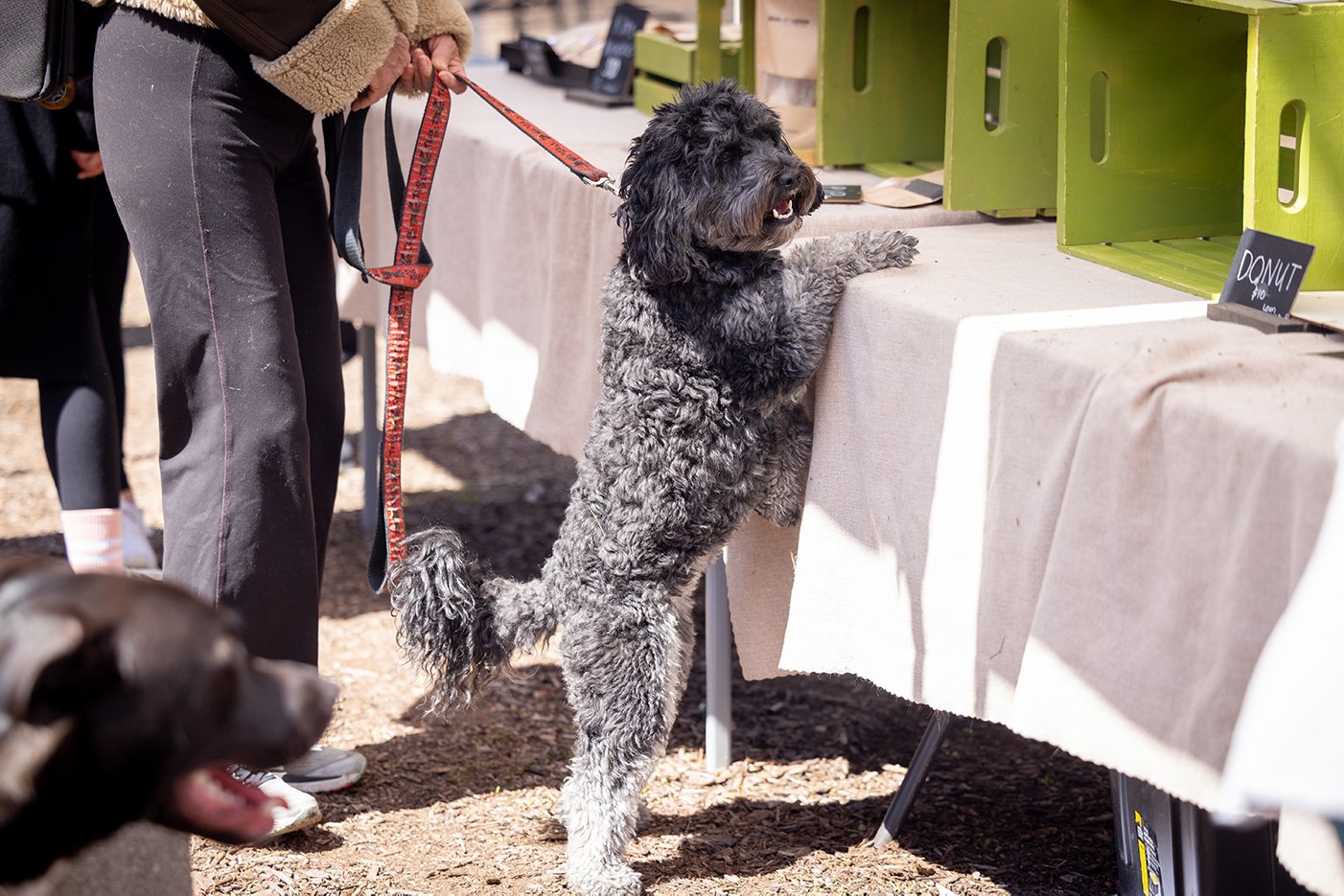25 Years After Its Start in a Chicago Alley, Green City Market Continues to Connect Local, Sustainable Farms to More Chicagoans Than Ever
Daniel Hautzinger
May 3, 2024

Get more recipes, food news, and stories by signing up for our Deep Dish newsletter.
Taylor Choy wakes up at 3:15 am on Saturdays. She has to get to a patch of Lincoln Park across from the intersection of Clark Street and Lincoln Avenue by 4:30 to meet the trucks and vans of farmers who have woken up even earlier to drive from their plots in Illinois, Indiana, Michigan, and Wisconsin to sell their produce to Chicagoans. Within hours, the area will be teeming with neighbors wheeling carts full of carrots, mushrooms, apples, and ramps alongside dogs begging for their own food from Treats de Cuisine. Families with strollers and scooters will bask in a fresh spring breeze on the sunny lawn while snacking on pastries from pHlour Bakery and listening to musicians set up on the sidewalk adjoining Clark. Athleisure-clad young people will carry tote bags and iced coffees from Kikwetu as they wait in snaking lines for bagel sandwiches from Dorothy’s and grilled cheeses from Gayle V’s.
On the second Saturday of its 25th year a few weeks ago, Green City Market (GCM) welcomed a record-breaking 22,126 people.
But before the crowd descends, Choy, GCM’s operations and programs director, must help farmers, bakeries, butchers, and small-batch producers set up their stands along a paved path near the zoo. GCM adopted this linear set-up during the pandemic, and has kept it that way to make it more accessible, rather than returning to rows of booths in the uneven, muddied grass.
That’s just one of the ways GCM, a nonprofit, tries to provide access to everyone, despite its main location in affluent Lincoln Park. Low-income shoppers can triple their Supplemental Nutrition Assistance Program (SNAP) benefits at the market. At the end of each market, unsold products are donated to food pantries in the city and GCM compensates farmers for the food that would have otherwise gone to waste. Kids can taste various products for free through a program called Club Sprouts and spend a dollar coupon on produce from one of its stands.
“Access to local food is a right, not a privilege,” says Mandy Moody, the executive director of GCM. “Everyone should have access to locally grown, sustainably produced food.”
GCM requires all its farmers to be certified as committed to sustainable practices. All of the farms are located roughly 150 miles or less from downtown.
“I enjoy connecting people to food and have a passion for food access,” says Choy, who has been with GCM for seven years and whose immigrant parents and grandparents ran a Chinese restaurant in Queens. “I love the tight-knit food community in Chicago, and [through GCM] I get to promote people who are using sustainable practices.”
The Origins of Green City Market in Connecting Farms to Restaurants
Farmers markets today are as essential to Chicago summers as beach days and biking the lakefront. But 25 years ago, when GCM first started connecting local, sustainable farms to Chicagoans, they were relatively rare. Whereas there were 8,771 farmers markets across the country in 2019, according to the USDA, there were less than 3,000 in 1999. Chefs like Rick Bayless and Sarah Stegner had begun forging relationships with nearby farmers for their restaurant kitchens back then, but it was difficult for home cooks to access local produce in the city.
Stegner was the chef at the Ritz-Carlton dining room at the time. She was known for vegetable soups starring exceptional produce like over-wintered spinach. “In the wintertime, the stems freeze, and when they do, they become sweeter and sweeter, so it’s like candy,” she explains. She was leading a cooking demonstration featuring her spinach soup when she realized, “[Home cooks] can’t make this. You can’t get to the farmer that sells this.’ So we fixed that.”
With Stegner at that demo was the cookbook author and food columnist Abby Mandel, who died in 2008. Inspired by the markets she had seen in Europe, Mandel decided to bring a local, sustainably focused farmers market to Chicago by reaching out to farms through chefs like Stegner and Bayless.
“The chefs in the area had relationships with local farms and were bringing in this beautiful produce, and it was on the menus,” Stegner says. “People wanted access, and Abby knew that that was something that we could do.”
The first Green City Market took place in an alley next to the Chicago Theatre in the Loop. It featured nine farms, four of which are still a part of it today. One of them was Mick Klüg Farms in southwestern Michigan. Klüg had formed a relationship with Bayless at a farmers market at Lincoln Park High School, according to Abby Schilling, who took over ownership of the farm from her father Klüg several years ago. Bayless would drop his daughter off at the Klüg stand to be watched by Klüg’s mother while Bayless shopped for his restaurants.
“Rick Bayless was one of the first chefs that purchased direct from farmers at that market,” Schilling recalls. Klüg eventually started delivering directly to Bayless and other chefs in Chicago, then extending his trip to the city to sell at Green City Market, which soon moved to Lincoln Park. The popularity with chefs of Klüg’s produce, which still can be found on menus across Chicago, “skyrocketed because of Green City Market,” says Schilling, who worked the Klüg stand at GCM every summer while growing up. “It was such a popular destination for chefs, and they would come see him there and pick up, and that’s how a lot of those relationships were formed.”
GCM continues to try to foster such relationships between local farms and chefs, in part to provide a sustainable source of income for the farms in order to help them survive. According to the USDA’s 2019 National Farmers Market Managers Survey, farmers markets helped farm vendors increase overall production, employment levels, types of produce grown, and sales of products that would otherwise not sell.
“Without vibrant farmers markets and chefs who cook with the local bounty, many family farms get gobbled up by agribusinesses that produce lifeless grocery store commodities,” says Bayless, who was a founding member of GCM and whose Frontera Farmer Foundation also supports small, sustainable farms in the Chicago area. “Seasonal, locally crafted fruits and vegetables from family farms are different from all that. They’re fully ripe and flavorful, diverse and beautiful. They taste of a place and time. And they have been nurtured along by good people who’ll say, ‘Hi,’ and share a recipe or two."
GCM has funds available to provide assistance to vendors in a crisis, as well as for first-time vendors. It also encourages its prepared food vendors to source the majority of their ingredients from its farmers, including at its popular annual fundraiser, Chef BBQ, when Chicago restaurants also get in on the game. Some of those vendors have built up enough of a following at the market to grow into larger enterprises, as Hoosier Mama Pie Company, Floriole, and Honey Butter Fried Chicken did, and continue to use ingredients from local farms.
“We do our best to introduce [chefs] to new farms and to really help them make those connections,” Moody says.
“My job is so much easier when I’m using local produce. It stacks all the cards in my favor,” says Stegner, who is on the board of Green City Market. “Every chef arms themselves with the best product possible.”
Connecting Farms to Home Cooks
The allure of outstanding local products isn’t confined to chefs. “Once you’ve had that juicy, run-down-your-arm strawberry, you can’t go back,” says Moody. But not everyone can afford it – which is why GCM offers its SNAP matching program in partnership with Experimental Station and through funding from donors. A customer that spends $25 of their SNAP benefits at GCM receives an additional $75 in vouchers or tokens to be used at the market. That match allows some customers to shop at GCM as a first choice to feed their family, rather than use up any leftover benefits (which are rare) there at the end of the month because other suppliers were cheaper.
“In a dream world, I would love for everyone to shop from Green City first, from my local farmer first, and then I’ll fill in whatever I can, versus the other way,” says Moody. Last year, the program generated a quarter of a million dollars in purchasing power for SNAP beneficiaries, according to Moody, with participants coming from over 100 different ZIP codes.
“It’s a benefit for our farmers as well, because those SNAP dollars would have been spent at big box stores, and those big box stores are already getting enough of the market share of that dollar,” Moody says. “We want to redirect that spend with the local economy as much as we can.”
A farmers market also provides an opportunity for face-to-face interaction with the people who produce your food, allowing you to learn from them and discover what’s tasting the best that season. “It provides [customers] with an opportunity, unlike a grocery store, to actually speak to someone that is growing their food,” says Klüg Farms’ Schilling.
“Don’t miss out on the opportunity to really interview them,” advises Stegner, who notes that Wednesdays or early Saturdays are good times for a conversation, since the market is less crowded. “You have access to a farmer or somebody working the land, and that is so valuable because they’re educated about what the season looks like, how the weather’s affecting things, what variety and breeds they’re offering. It’s a dialogue.”
The benefit of face-to-face interaction is mutual: it gives Schilling and other farmers a chance to hear directly from their customers, and cuts out the middleman of an agricultural broker or processor, increasing profits for farmers. Without the steady income of farmers markets like GCM, Schilling says, “I definitely think there wouldn’t be as many small-scale farms within a 100-mile radius of Chicago.”
Schilling started going to farmers markets with her father when she was seven and even nannied for some of his customers. Her own children might be ready to work the stand at the market soon.
“It’s such a relationship-based business model,” she says. “That adds to quality of life. We’re not only here on the farm grinding it out and dealing with the weather. We have the opportunity to go into the city and have these relationships with families and chefs and restaurateurs and grocers.”
Green City Market Today
Green City Market has sixty total vendors this year, roughly two-thirds of whom are food producers like farmers. The other third sell prepared foods; you won’t find any crafts or art here. Some farms are newcomers, like the meat purveyor Willowbrook Farms from southwest Michigan, while others – Klüg, Nichols, Smits, and River Valley Ranch – have been there since the beginning. Today, GCM hosts markets on Saturdays from April through November and on Wednesdays from May through October in Lincoln Park; on Saturdays from May through November at Mary Bartelme Park in the West Loop; and from December through March indoors in Avondale.
It’s a big step up from a sparsely attended gathering of a few farmers in an alley 25 years ago.
“Green City Market set the bar high, and it galvanized a whole new group of people to shop locally,” says Bayless. “And the success bred success, as markets began springing up all over town, making seasonal, local produce available to wider group of cooks and eaters.”
In 2024, there are 42 farmers markets listed as part of the Chicago Farmers Market Collective in the city alone. But Stegner emphasizes that small, local, sustainable farms are still not the norm. And their survival is tenuous, in the face of climate change, inflation, corporatization, and other factors that affect not just them but also restaurants and anyone that has to eat – that is, everyone.
“It isn’t a given that we will have these farms,” she says. “It is a tentative hold that we have on them, and as successful as Green City Market is, if we take our eye away from the importance of this, we could lose it.”
















